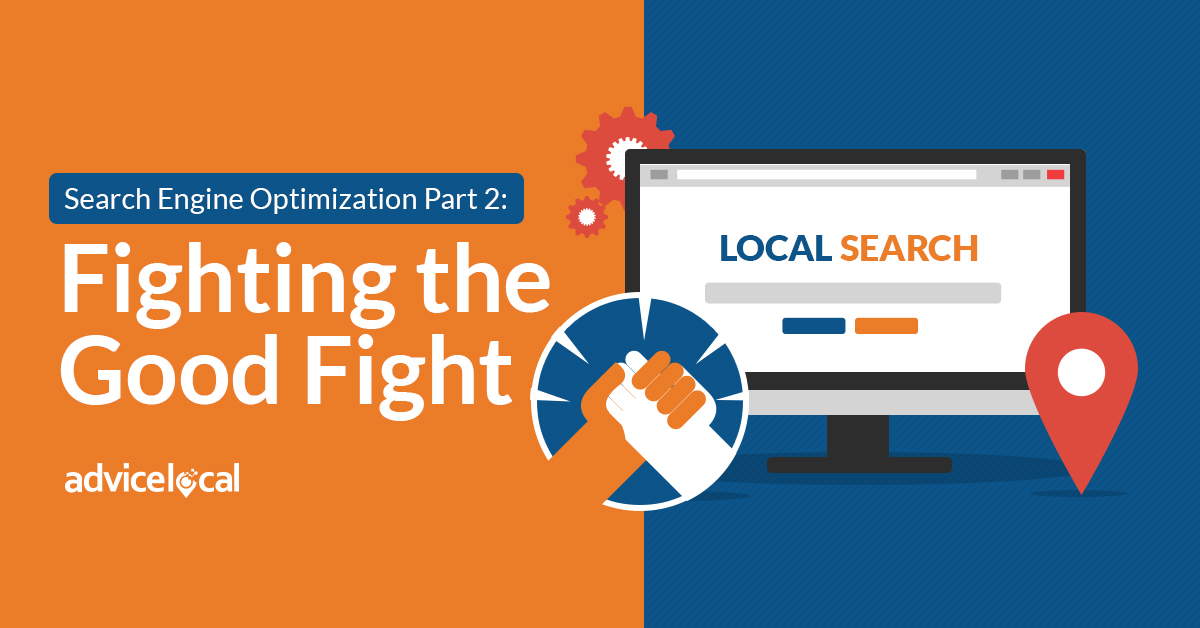In part 1 of this article, we started down the SEO 101 rabbit hole with stats revealing the power of well-implemented local SEO, a brief overview of what search engine optimization is and the all-important list of what NOT to do to succeed. Today, I get to share the good stuff; without any further delay, let’s get the businesses you represent moved up in search engines!
Get to Know Good SEO
By now, you probably already know SEO is largely keyword-driven. After all, people enter specific terms in the search bar and hope to be rewarded with relevant results. The ultimate goal is to have your website or your client’s website to appear when a relevant query is entered.
Google largely relies on its algorithmic evaluation of online content, due to the sheer vastness of the Internet. But this isn’t to say that a website’s worth is only judged by how well the content targets a certain set of key words and phrases. Current search engine algorithms are more intuitive, able to discern both the intent and the context of a particular search, according to Google’s Sridhar Ramaswamy, SVP of Advertising and Commerce. This means algorithms, like RankBrain, Google’s machine-learning program, are getting closer to thinking the same way that people do, and are placing greater emphasis on human factors, which determine quality and user experience. For reference, see the Search Quality Evaluator Guidelines released in November and updated in March.
The emphasis on quality and relevancy becomes greater with the consistent evolution of website evaluation methods, as Google’s algorithm updates have proven. However, the mistake that many less-experienced online marketers make, is paying too much attention to algorithms, almost trying to reverse engineer them to better understand how to manipulate them. Instead, you should focus on E-A-T content and good design elements, which influence user experience.
Onsite Factors: On-Page SEO
- Quality content which helps (solves a problem), educates or entertains
- Relevant keyword and phrase use without stuffing
- Fresh content, following trends related to your niche
- HTML title tags for headings and subheadings, which are descriptive and use keywords
- Structured data for greater machine readability
Dive Deep into Keyword Research
A large part of the SEO battle is choosing the best keywords to target. Obviously, the words need to be relevant to the niche and should include terms the potential customers are most likely to use in search.
For location-based businesses, with a specific service area or a traditional brick-and-mortar business, choosing the right keywords to target is somewhat easier, since you’re primarily using one or two words combined with the name of your town, city or other geographic region. These markets tend to be less competitive than those with a global reach.
Free tools for Easier Keyword Research
- Google AdWords Keyword Planner is a free online tool, which provides useful keyword suggestions, including information such as monthly global and local search volumes and the level of competition.
- Google Autocomplete suggests search terms as soon as you start entering a query into the search bar. This can give you a good idea of which terms are most popular.
- Google Trends displays hot topics and related keywords to give you an idea of which subject matter is currently drawing the most attention in the online world. You can specify a category to help narrow down your search.
Keywords can be thought of more as phrases, and there are two main kinds. The first are long-tail keywords, made up of three or more words, which are less competitive and tend to be more effective in bringing in quality, relevant traffic. Many marketers prefer to target these longer phrases. However, it’s also wise to compete for and use the second variety, short tail keywords. These short phrases, which have three words or less should also be targeted at the same time. There will be more competition, but it will help websites to show up in more relevant searches.
All functions of SEO don’t actually take place on the website itself.
External Factors: Off-Page SEO
- There should be a number of relevant, quality backlinks from other trusted websites.
- Your links need to contain relevant anchor text, that is text related to the pages/ information users are guided to when they click.
- Domain age and authority. Although you cannot change the age of your website, you can follow good SEO practices to increase your site’s authority.
- The number of people sharing your content on social networks, which affects the reputation of your website.
- Review sites have the power to affect your website’s optimization and reputation. Although online, what happens in-store or on-site drives this factor for brick-and-mortar locations. Be sure the companies you represent know to address reviews, both positive and negative.
While nothing guarantees top search placement, digital marketers should work on making sure all of these factors work together to complement and build upon one another.
Remember, having optimized business listings on Google, Bing, Yahoo, review sites and authoritative niche directory websites is also part of a strong off-page SEO strategy. These give you solid and trusted backlinks as mentioned above.
Another key function that happens behind the scenes occurs with the creation of a Sitemap. A sitemap is a listing of all of the pages on your website, along with their titles and URLs. There are multiple free tools available, either directly from search engines or third parties, to help create useful sitemaps.
These maps tell search engines about the structure of a website and make it easier for search engines to crawl a website. Crawling simply refers to a search engine’s ability to search through the vast information throughout the Internet, and return relevant information based on the original search query. It then indexes, or provides this compiled list of Web pages, in an order determined by the algorithm.
Once the sitemap is created, it is imperative to submit it to Google, Bing or your search engine of choice through its Webmaster tools interface.
SEO Success Remembers the User Experience
To really succeed in the SEO game, you need to think beyond algorithms, on-page and off-page functions; it should always work alongside user experience.
Offering an excellent user experience combined with quality, useful content, backed up by a strong value proposition needs to be the number one priority. Driving traffic to a website is only part of the greater goal. When a consumer lands on a website, the experience you’ve created there, determines how long they stay, what they choose to click on and whether or not they work their way through the funnel to purchase download or take the action desired by the client. This obviously varies based on the business’s goals and where the user lands when they arrive on the site from their initial search.
Make sure to keep up with the many changes that come from each of the major search engines. In this mobile-first world, there seems to be a minor change almost monthly. Major shifts are easy to identify because EVERYONE talks about it. Pay close attention to industry publications, known for breaking news about smaller updates. Fighting the good fight in SEO is just as much about technical skill as it is about being informed and willing to learn.
Are you ready to take on the next SEO battle? Advice Local has a team of digital marking professionals ready to help! Learn more today about our solution.
Be sure and come back for more local SEO tips from the #QueenofLocalSEO next week!





One thought on “Search Engine Optimization Part 2: Fighting the Good Fight”
Comments are closed.